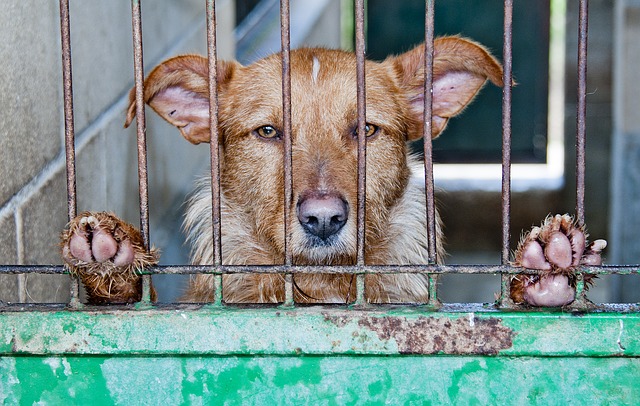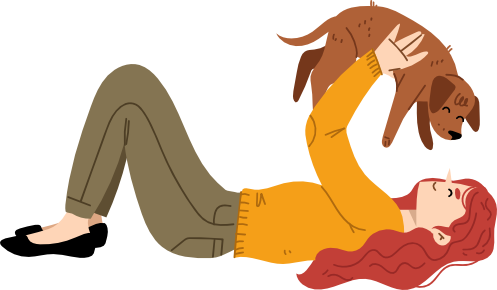Dogs are social creatures – that’s why many of them really don’t like being left alone when we’re gone. But what about when a dog goes from just being a bit lonely (pretty normal) to a full-blown panic attack?
In today’s Ask a Behavior Consultant question, we’re looking at the case of a dog who breaks out of her crate when her owners are gone.
She gets anxious and destroys her bed and tries to escape from her cage trying to find us.
– Pitbull Escapee
This owner said that they’ve tried giving elk antlers and a toy. That’s helping keep their dog from destroying her bed, but the escape and crate destruction continues.
Does Crate Escaping Mean Separation Anxiety?
Unfortunately, an escape-proof crate is probably not the solution here. Without filming the dog while the owners are gone (I use a Furbo to spy on my dog), I can’t say for sure. But escaping from a crate is a pretty extreme behavior, and it could be indicative of separation anxiety.
It’s important to film and watch your dog to narrow down your “diagnosis.” I’ve heard of cases where the symptoms sounded like separation anxiety, but video review revealed that the dog was responding to a mailman, a noise phobia, or pain from a bark collar!
This dog might just have an extreme crate aversion. It might be worth it to test out leaving her inside of an exercise pen (she probably will need one with a top) or even loose inside the house to see what happens. Again, let’s film her in the crate and outside the crate first.
If this dog just hates the crate, we’d expect her to remain calm outside of the crate. Sure, she might chew up something – but she’ll probably sleep, play, eat, and drink normally.
But if she’s got separation anxiety, we’re more likely to see symptoms of anxiety, such as:
- Pacing
- Panting
- Whining, barking, or howling
- Drooling
- Refusal to eat
- Fixating on doors or windows
- Lethargy or hypervigilance
- Digging, chewing, or other destruction – especially if it’s aimed at doors or windows
My own dog suffers from some mild separation anxiety. When he’s not feeling good, his big symptom is that he won’t eat his bully stick. I’ll also often notice that his paws are soaked, because he licks his forepaws when he’s alone.
I’ll say it again: filming your dog is the best way to figure out whether this crate escaping is due to separation anxiety, or something else.
If it’s just the crate that’s the problem, we can work on teaching her not to chew. But if it’s separation anxiety, our treatment plan will be quite different!
Click to Enlarge Image
It Looks Like Separation Anxiety. How Do I Help Her?
If the video points towards separation anxiety, don’t panic. Though solving separation anxiety can be a long road, it’s usually a very successful one!
Consider a Separation Anxiety Course
Here at Journey Dog Training, we offer a 6-week separation anxiety course that’s designed to help you and your dog solve separation anxiety from home. Though we also can work with separation anxiety through our other services, this course is hands-down your best bang for your buck!
Pharmaceuticals
Many dogs with separation anxiety benefit enormously from pharmaceutical help. Basically, your dog is having a panic attack whenever you leave. Medications can soothe those panic attacks without sedating or “drugging” your dog. Talk to your vet about anti-anxiety medication.
This is especially important if you work or go to class and have to leave your dog frequently.
Once you’ve got medications on-board (or not, if your vet thinks that medication isn’t right for your dog), it’s time to get down to work with training.
Avoid Panic at All Costs
Your dog can’t be left alone for longer than she can handle. This means you’ll need to get help from a dogsitter, doggie daycare, local college student, friends, family, a dog-friendly workplace, or a work-from-home setup to keep your dog from panicking. This is a pain, but it’s very important for success.
When I was in college, I dog-sat a dog with separation anxiety. This arrangement was perfect: I charged far less than a doggie daycare, the dog got private care from a student, and I (the student) could “pretend” to have a dog 5 days a week without actually having full financial responsibility for a pet I wasn’t ready for!
Teach Your Dog That Being Alone Isn’t So Bad
“Pitbull Escapee” is on the right track with the elk antler! Unfortunately, it doesn’t sound like the pup is interested enough in the elk antler to actually be soothed. Some dogs with mild separation anxiety can be really helped with a flipped morning routine paired with some great puzzle toys and chewies.
But many dogs with true separation anxiety aren’t actually interested in eating when they’re left alone. They’re just too scared to eat!
That’s ok. That’s where the training comes in.
Successful separation anxiety training is based on desensitization and counterconditioning.
Basically, if your dog can currently handle being left alone for 10 minutes before getting worried, that’s where we start. If your dog gets worried as soon as you brush your teeth and grab your keys, that’s where we start.
A class (like ours) or trainer will help you craft a plan that’s specific to your dog. We also have a FREE separation anxiety training plan that we’ll email you, if you’d like.
This plan will generally include leaving the house for micro-absences, then returning without fanfare. The goal is to slowly teach your dog that being left alone is no biggie.
Remote treat dispensers (especially those with cameras, like the Furbo) can be really helpful for this. You can monitor your dog with live video AND give your dog treats while you’re gone!
If your dog gets anxious BEFORE you’ve even left, then you’ll have to do things like picking up your keys and putting on your coat, then sitting on the couch to watch TV.
Finally, a big component of many successful separation anxiety treatment plans is teaching your dog not to shadow you. The Karen Overall Relaxation Protocol is very helpful for this.
How NOT to Fix Separation Anxiety
Solving separation anxiety is NOT about punishing your dog for destruction or barking. This will often make things worse. It’s also not about exercising your dog more (though that might help a bit) or about calm, assertive energy.
It’s about systematically teaching your dog to be alone – sometimes with pharmaceutical help.
If your dog is simply improperly crate trained and a bit destructive, you’ve got a different training plan. That’s why video is so important! We’ve got to know what we’re treating.


